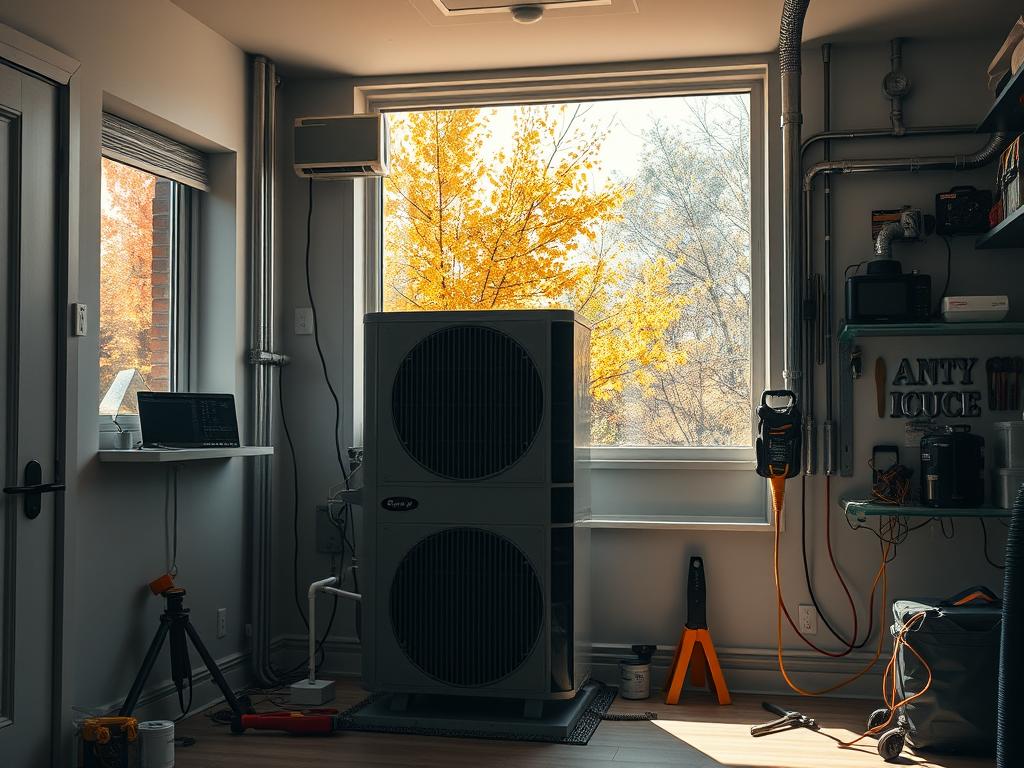
As the leaves change and the air gets crisp, it’s crucial to prepare your home for the cooler weather. You need to keep your living space safe, efficient, and protected. This checklist will help you protect your home and stay calm through autumn and winter.
Regular autumn maintenance can save you from big repair costs. It also makes your home more energy-efficient. Sealing drafts and cleaning gutters are just a few steps that help. This guide covers everything to get your home ready for the cold months.
Exterior Home Maintenance Tasks
With leaves falling, it’s time to get your home ready for winter. It’s key to focus on things like cleaning your gutters, checking your roof, sealing air leaks, and taking care of your siding. Doing these tasks keeps your home safe and can also help it last longer. Here are the main tasks:
Clean Gutters and Downspouts
It’s important to clean your gutters in spring and fall. This stops blockages that could cause expensive water damage. The cost to fix gutters in the U.S. averages about $384. So, regular cleaning saves money in the long run. It also stops water from harming your home’s foundation and structure.
Inspect and Clean the Roof
Checking your roof carefully can stop damage and help it last longer. In 2022, 38% of homeowners had sudden roof damage. It’s smart to remove debris and look for damage or leaks. You might want to hire experts for a thorough check. They can spot problems you might miss.
Seal Air Leaks
Sealing leaks around windows and doors can cut heating and cooling costs by up to 15%. Energy Star suggests using caulk or weather stripping for this. Sealing gaps keeps out cold air, making your home cozy and saving energy.
Inspect and Clean Siding
Keeping your siding in good shape is vital for your home’s exterior. Look for cracks or damage that could let in cold air or moisture. Cleaning with a pressure washer can remove dirt and mildew. This keeps your siding working well and looking great. For more helpful tips, check out this detailed checklist.
Making these exterior home maintenance tasks a priority helps protect your home from seasonal problems. It also gives you the comfort of knowing your home is well-cared for.
Fall HVAC Maintenance Highlight
Getting your heating system ready for winter is very important. That’s why autumn is the best time for heating system maintenance. Doing this maintains system efficiency and keeps your home warm all winter long.
Schedule Annual Heating Tune-Up
An annual furnace check-up is key for efficiency. A pro will look over, clean, and tune-up your system. This step keeps your HVAC working well and avoids breakdowns when it’s cold.

Check and Replace Furnace Filters
Checking and switching out furnace filters is easy but crucial. Clean filters mean better air, more efficiency, and a longer-lasting system. It’s wise to change these filters often, especially when you use your system a lot.
Clean Outdoor HVAC Units
Remember the outdoor units too. Dirt and debris can gather, lowering your system’s efficiency. Keeping outside parts clean ensures your system runs well during the heating months.
Interior Home Checks for Fall
Making your home ready for winter is key. You need to do some vital checks inside your home. These steps are crucial for staying safe and warm.
Test Smoke Alarms and Carbon Monoxide Detectors
Start with checking your smoke alarms and carbon monoxide detectors. It’s super important to make sure they work well. This keeps your family safe by alerting you early if there’s smoke or gas.
Testing them once a year is a good rule. This way, they’ll work right when you need them.
Adjust Thermostat Settings
When it gets colder, it’s time to adjust your thermostat. You want your home cozy but don’t want to spend too much on heat. Using a programmable thermostat can help, adjusting the heat for you.
Drain the Water Heater
Your water heater needs attention too. Draining it once a year can stop sediment from hurting its performance. This task saves you money and can make your water heater last longer.
For more tips on getting your home winter-ready, check the Fall Home Maintenance Checklist. Taking care of these things helps keep your home safe and comfy during the cold months.
Fall Lawn and Garden Care
As we move outdoors, your lawn and garden’s health matters a lot for spring. Doing tasks like the final mow, aeration, and putting down fertilizer will help. It also means protecting your plants so they can thrive after the cold months.
Last Mow Before Winter
The last mowing is key for preparing your lawn for winter. Set your mower to around 3 inches high. This height is best for most grasses in the fall. Cut your lawn shorter in late fall, about 1-2 inches, to prevent snow mold and ready the grass for winter rest. By mulching leaves into tiny pieces and mowing over them often, you help the soil. This boosts microbes that break down organic stuff for free.
Aerate and Fertilize Lawn
Aerating your garden in the fall is crucial. For grasses that grow in cool weather, aerate in early fall. But if you have warm-season grass, spring is better for aerating. Keep the thatch layer under an inch thick. If it’s more, dethatching helps. After dethatching and aerating, spread some high-quality soil over your yard, about ¼- to ½-inch thick. Fertilizing in fall with products like Scotts® Turf Builder® Thick’R Lawn™ helps fix summer-damaged roots. It sets the stage for a green, thick lawn in spring.
Prep Trees and Plants for Winter
Protecting your plants correctly is vital to help them survive the winter’s freeze. Water your trees and plants well. Then, put down a thick mulch layer and fend off pests. Ignoring your garden now can cause a lot of harm. Also, make sure to clear out your irrigation system by using compressed air or opening the drain valves. This way, the system won’t get damaged and will be ready for next year.
Conclusion
As fall comes, it’s key to start on home maintenance. This ensures your home can handle the season’s challenges. Our checklist guides you to keep your place safe, working well, and cozy.
Start with outside jobs like cleaning gutters, checking the roof, and fixing air leaks. This prevents damage and makes your home last longer. Inside, make sure your HVAC system is up to snuff. Get heating tune-ups and swap out air filters. Also, don’t overlook testing smoke alarms and draining the water heater for your family’s safety.
Don’t forget your yard. Get it ready with aeration and fertilizer for a healthy lawn. Seasonal tasks like gutter cleaning and sealing windows also keep your home in top shape. Following this fall guide helps with smooth seasonal care. It sets you up for a stress-free winter and a lively spring.



